We are a part of everything we have come from. Our ancestors’ experiences created the world that we now inhabit. Often, their lives are described in clues all over our houses.
So what can we learn from the tangible objects that have been passed down within our families?
Heirloom is a participatory exhibition that provides an opportunity for girls to learn about their own families’ histories through interviews and researching old photographs, artifacts, and heirlooms.
Girl Museum aims to empower girls with knowledge and understanding of the present day through learning about the past. This fit perfectly with the 2013 International Museum Day theme, Museums (Memory + Creativity) = Social Change, so we have partnered with Chick History to produce our HEIRLOOM project.
To participate, view the contributions below to gain inspiration. Click the toggle box underneath the picture to discover its story. Next, click the button below to access our “How to Research Your Heirloom” guides. Then, send us a picture of your heirloom and its story, and we’ll feature it in this exhibit! Contributions are accepted on an ongoing basis.
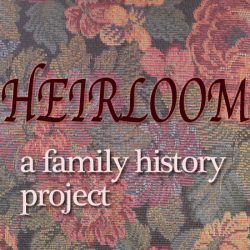
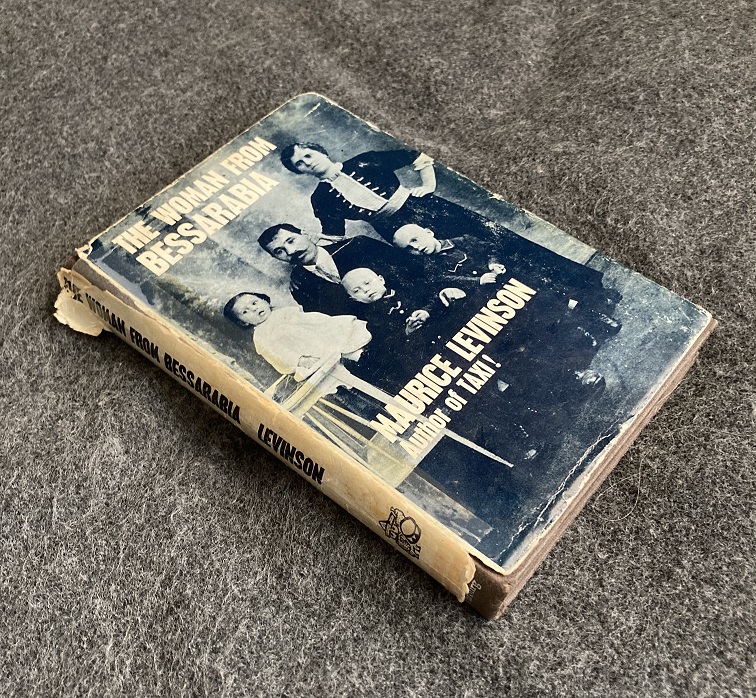
The Woman From Bessarabia
This book, The Woman From Bessarabia, was written by my great-granduncle (the brother of my great grandfather). It was gifted by Maurice, the author, to my grandmother and grandfather as a gift and has since been passed down to my mother, and eventually, I hope it will be given to me. Written as an autobiography, the book tells the story of my great-granduncle’s life and offers a raw insight into my family’s history.
My mother’s side of the family is Eastern-European-Jewish. I was lucky to grow up with a very close relationship with my grandparents. I would see them regularly and whilst we were not a practicing religious family, we would still get together on the major Jewish holidays such as Rosh Hashanah, Passover, and Channukah to celebrate with one another. As I have not been raised observing Judaism, I found reading my great-granduncle’s story interesting and insightful.
My great-granduncle’s side of the family was originally from Bessarabia, a country which was under Russian rule but now resides in modern-day Moldova. My great-granduncle was born in Kishinev, the then capital of Bessarabia which stood on the border of Russia and Rumania. He described it as the worst place in the world for Jews before Hitler came to power because of the pogroms which occurred. Pogrom is a Russian term historically used to describe violent attacks carried out by non-Jewish people on the Jewish community in the Russian empire. It was because of these pogroms that my family was displaced from Bessarabia and forced to leave their home. They wandered across Europe, without a passport or any money, the only languages they spoke were Russian and Yiddish (the language spoken by Eastern European Jews). Eventually they settled in Paris for several years before moving to London.
The book goes on to document the rest of my great-granduncle’s life, from falling in love to the death of his parents. However, for me, it is the first chapter which I find so interesting and historically significant. Having been born and raised in London, never privy to the atrocities of anti-semitism, I believe it important and necessary that I educate myself on my family’s history and the lengths they went through for me to live comfortably today as well as to attempt to understand the magnitude of the horrors historically committed against the Jewish community.
I have to say it does feel quite strange reading a piece of history and making the mental connection that this is actually my history. My book of choice does tend to be fiction, although I do read non-fiction from time to time. However, reading this non-fiction book was unlike any other I’ve read before as it is, in essence, a part of my life’s story.
I feel lucky to have such an important piece of my family’s history recorded and so beautifully written and I definitely intende to pass it down to future generations so that they can read a first-hand account of their family’s history.
-Anais Pedron
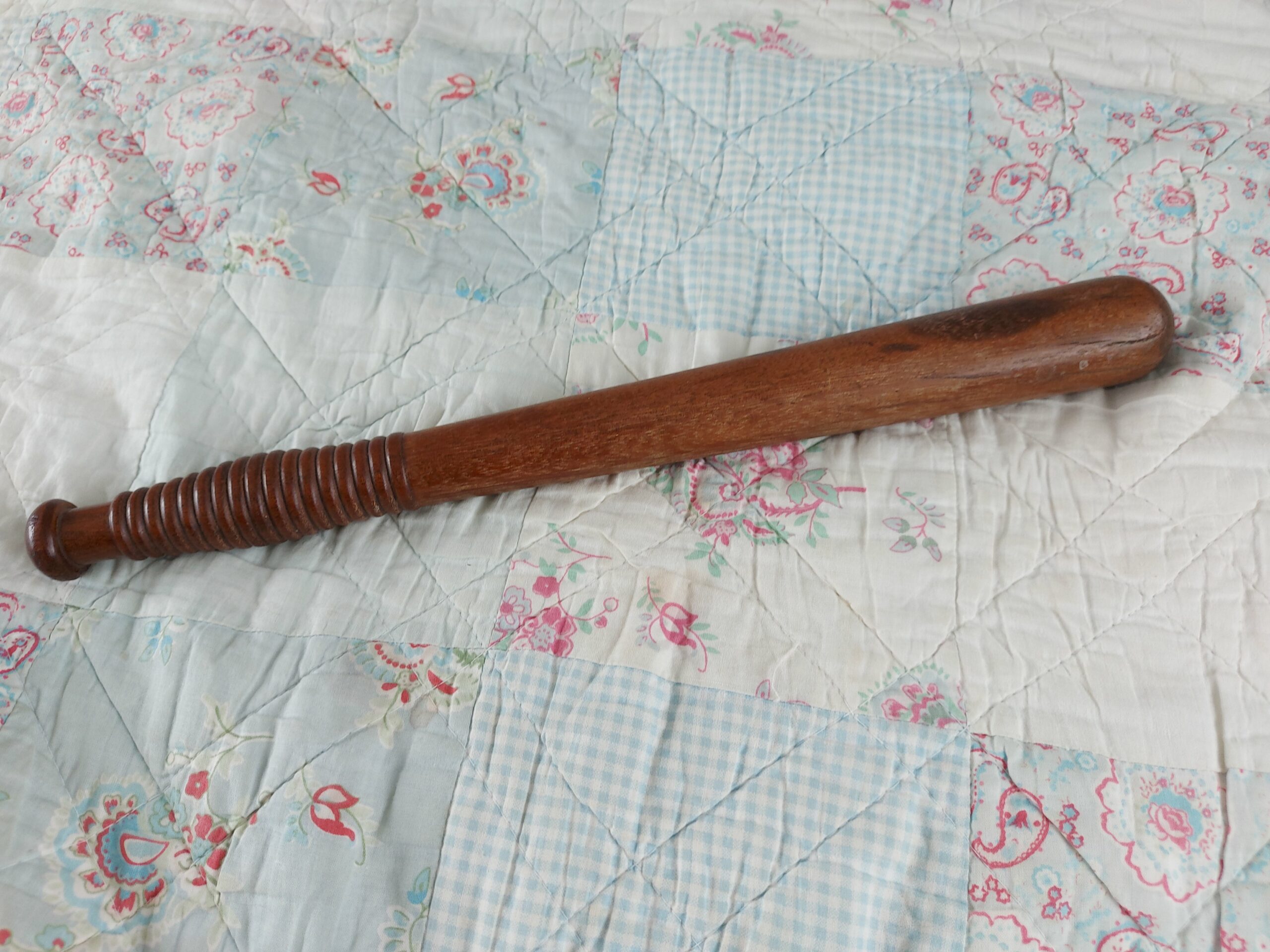
Home Guard Truncheon
This truncheon was issued to my great grandfather, Horace Blundell, during his time as part of Birmingham’s Home Guard in World War Two. In speaking with mum, I discovered that part of the Home Guard’s job had been to try and stop looting during air raids and the truncheon was often their only form of defence.
Horace was very fit due to his job as a carpenter which required a lot of manual labour and this, combined with his hard, working-class Lancashire background, meant that he was a real force to be reckoned with. My nan said that he had definitely used the truncheon on looters several times and I can only imagine how that must have gone if he was as tough as mum says.
When the Home Guard weren’t using their truncheons to stop looters they were using them to smash through glass and other materials in order to help rescue people who had been trapped due to bombing. This would have appealed to Horace a lot, mum says, because he was so determined to help with the war effort and so being able to do something that meaningful meant a lot to him.
In fact, mum believes he probably held onto the truncheon because it was a symbol of all that he did for his country. He’d been so frustrated that he couldn’t participate in active service as during WW1 he had been too young and by the time WW2 broke out he was too old so being in the Home Guard was an honour for him.
Mum and I both really love having this tangible connection to something that was not only a major part of history but was also very important to my great grandfather. For Mum, she has said that when I was little and Dad was away a lot she slept with it under her pillow as a bit of a talisman of the past and that brought her a lot of comfort although she’s not entirely sure why.
Not only that but talking about this heirloom opened up a whole new discussion of a man that mum’s always wished I could have met because she loved him so much. This discussion led me to learning far more about him and to looking at more items that we have of his, like paintings he made with poems on the back written for his wife after she died. It’s made me feel so much closer to him, so I am grateful to this project for that.
-Molly Ashmeade
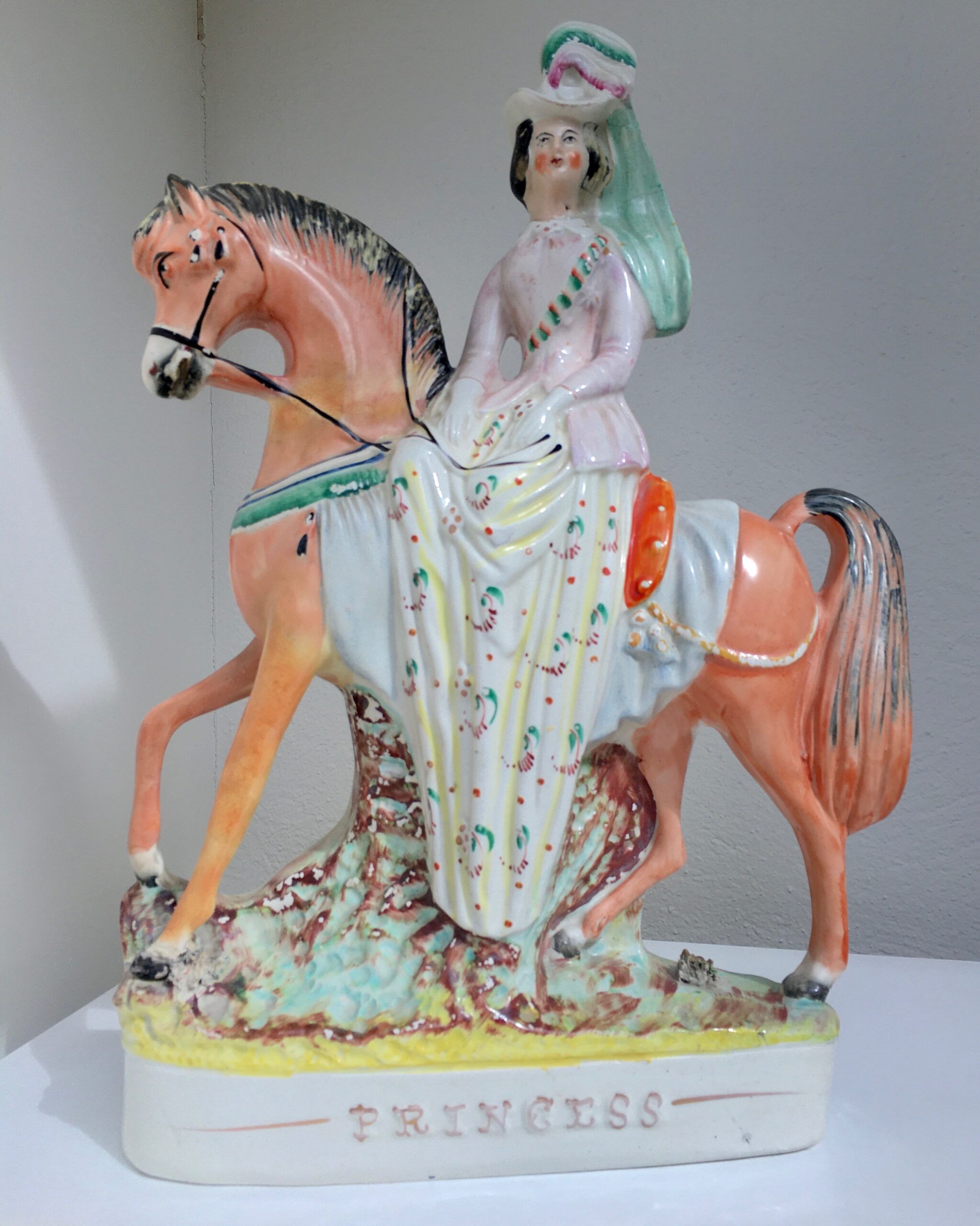
Princess on Horseback figure
I will always have happy childhood memories of staying with my grandma in a little village in the South West of England. We were often invited for tea and cake at the cottage next door where my grandma’s best friend and neighbour, Eleanor, lived. I was fascinated wandering around her sitting room; every cupboard, shelf, fireplace and window ledge was adorned with interesting painted pottery figures and animals. Eleanor had a great affection for Staffordshire Pottery, passed down to her from her mother. On retiring from the army, she had built up quite a collection and restoration business over many years.
I was the type of girl who loved Disney princesses and ponies after having just started horse riding lessons, so the Princess on Horseback figure always stood out to me. Eleanor informed me that the statue was Princess Victoria Adelaide Mary Louise, German Empress and Queen of Prussia and the wife of German Emperor Frederick III. She was the eldest child of Queen Victoria and Prince Albert. The figure was produced in the 1860s when there was popularity for collecting figurines depicting famous personalities of the period.
After Eleanor sadly passed away at the grand age of 93, the princess joined our family. On further investigation, I discovered she was originally sold as a pair with a figure of her husband, Prince of Prussia, facing her riding an identical horse. I would like to imagine one day she will find herself on display in the drawing room of a grand country house of the period she was created, even better if she was reunited with her Prince once again.
– Olivia Richardson
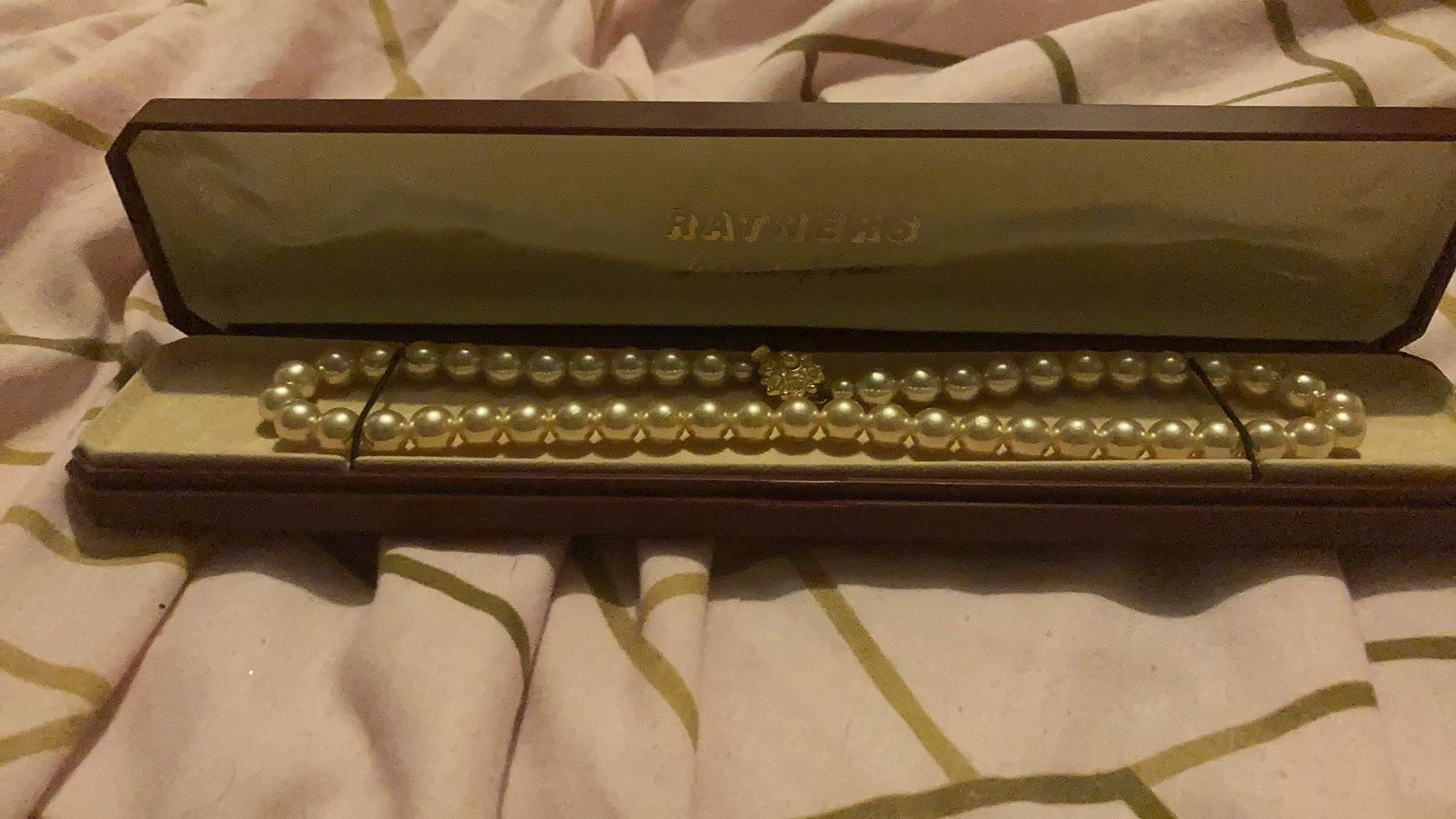
Family Necklace
Ever since I was a little girl I would sit on the bed with my mother and look at mom and nan’s jewellery. I loved looking at the pieces so much and I loved hearing the stories that went with some of the pieces. I had also loved one particular piece from the late 1940’s or early 1950’s. A white, fake pearl necklace with a silver metal clasp at the back, kept in a red velvet necklace box.
My nan wore the piece when she married my granddad in October 1963 and my mom wore the piece when she married my dad in June 1994. My mom has said that I can wear the piece when I get married in august this year. I am thrilled that I will be able to wear the same piece that both my nan and my mom wore on such an important day.
The story of the necklace that my mom has always told me is that the necklace was a gift for my great grandmother from my great-grandmother to mark the end of WW2, I have also heard from my mom that maybe that is just a story my nan was told my great grandmother and that possibly she brought the piece for my nan as a gift. We are not entirely sure on the full story of the necklace but all the same I have always loved the piece and I like ether story that goes with the necklace.
Even without a full understanding on when the piece was purchased and for what purpose, there is a strong history in the piece being worn for weddings, which is definitely true as you can clearly see the necklace around the necks of my mom and nan in the wedding pictures. I hope that if I ever have children, that if I have a girl, she too will want to wear the necklace.
-Charis Gambon
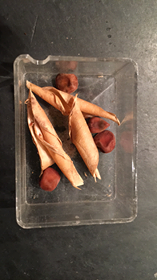
Peas from King Tutankhamun’s tomb
On my 18th birthday my grandma handed me a small saffron box with four dried peas rolling around inside. My grandma, who is a great lover of history, has a gift of extracting fascinating family stories from friends and strangers. The story of the peas was possibly the most bizarre. The peas which were a present from Lord Cavanagh’s daughter, a great friend of hers, were supposedly from King Tutankhamun’s tomb.
Tutankhamun, one of the most famous Egyptian pharaohs, who ruled between 1334 and 1325 BC. Although, his name rocketed to fame after his tomb was discovered by archaeologist Howard Carter in 1922. The expedition, which was funded by Lord Cavanagh, broke the 3,200-year-old seal to reveal hordes of artifacts and treasures intended to accompany the king in the afterlife. The antechambers revealed more than 5,000 artifacts including furniture, chariots, weapons, clothes and seeds of fruit and grain. My seeds were apparently taken by Cavanagh and sent back to his English estate.
The story may be totally fanciful, possibly some dried garden peas! The legitimacy is not that important to me, just the idea that they are thousands of years old brings the subject to life. These peas, which were carefully placed in a king’s tomb are now sitting in my kitchen cupboard! Recently, my friend asked me what I would do with the present, but I am yet to decide. I might plant a pea to see if it can still grow or more likely I will pass them onto my child on their 18th birthday to bring history to life for them. Since owning the peas I realised that it isn’t the historical object itself that excites me, it’s the story behind it.
-Topaz Brownhall
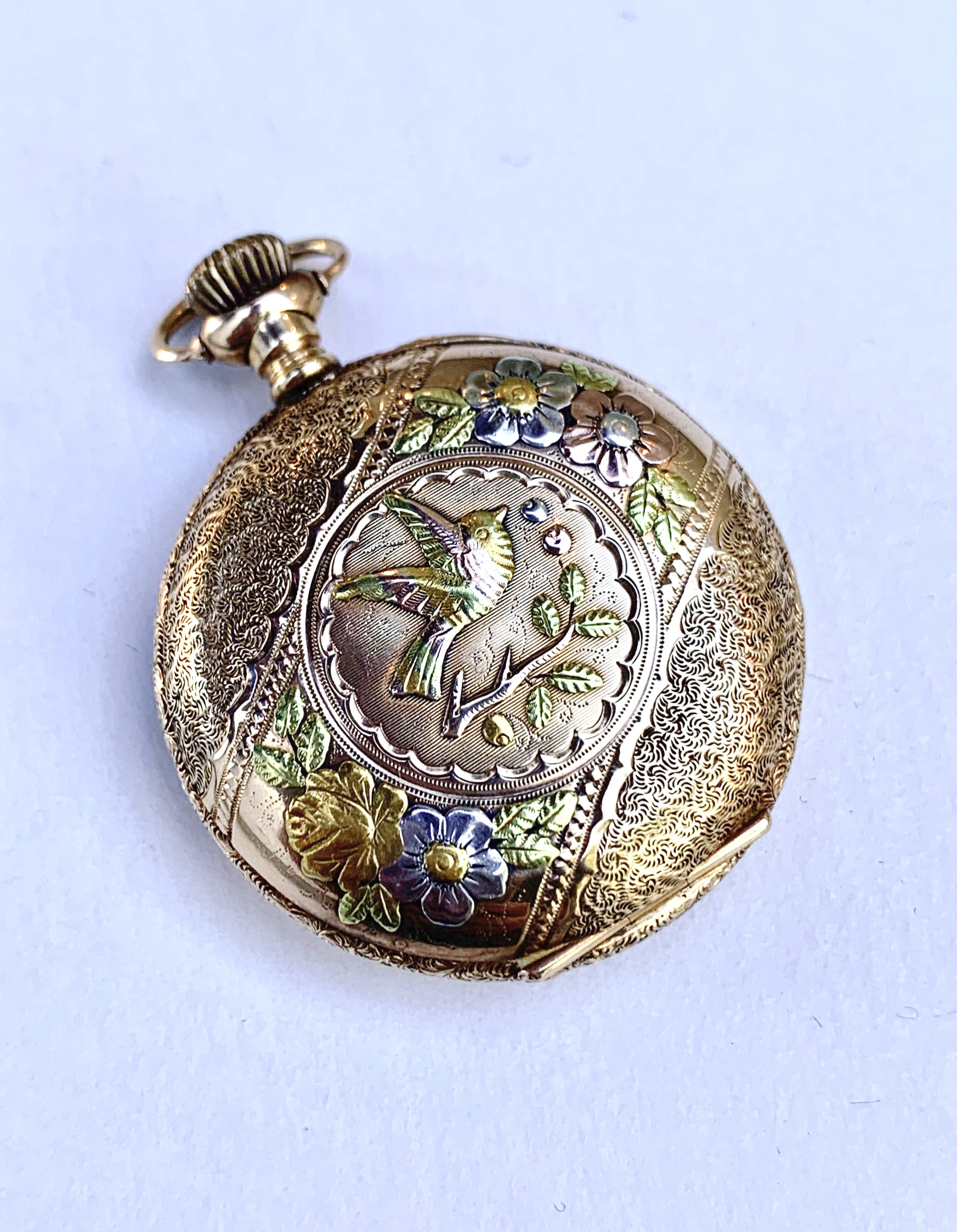
Mary's Pocket Watch
This delicate pocket watch is intricately linked to my family’s history. Crafted in the 1890s, the watch features shades of yellow, rose, green and blue gold. It was worn by my great-grandmother, Mimi, and previously belonged to her mother, Mary.
Mary was born in New York City in 1874, the daughter of two Irish immigrants. In 1895, she married a man named Robinson. They had two children: Mimi and her older brother, Raymond. In 1918, Raymond was tragically killed in the line of duty in World War I. Mary passed away shortly after, at the age of 45. Mimi was only 21 years old.
Throughout her life, Mimi dearly cherished her mother’s pocket watch. However, the watch itself had stopped working and it was too expensive to repair. She felt that if she replaced it with a modern timepiece, it would no longer be her mother’s watch. Instead, she had the watch sealed and converted into a brooch. Mimi wore it frequently for special occasions, pinned to her coat or lapel.
When my aunt was a little girl, she used to love to play in Mimi’s giant jewelry box. She remembers that the pocket watch was kept on the top shelf, in its own special place. (She even wore it a few times herself!)
Although I was never able to meet Mary or Mimi, their story is passed down through this beautiful pocket watch. It is truly a family heirloom.
– Summer L.
Majorica Necklace
When I think of a family heirloom, I usually imagine a piece of jewelry that has been handed down for many generations. There is usually a rarity or value that increases over the years. There is also a story behind the acquisition of that heirloom that connects the family members who wear it over the centuries. ALthough family heirlooms are not a part of my family’s history I can still relate to the tradition of handing down an object from one person to another over many generations.
My mother was born in Barcelona, Spain and lived during a time with political unrest during Franco’s regime in Spain from 1939-1975. Many of her family’s precious items were either stolen or confiscated. Under the influence of Franco, Catalonian people were wrongly convinced to be inferior in comparison to “pure” Spaniards. Cataloniains were banned from their language, penalized for speaking in public, or even practicing traditional dances in public. When my mother later moved to the United States she only brought what she needed. Most of our family’s memories were not in objects but in stories, or oral histories.
In that regard, my family heirloom is a piece of jewelry that my mother gave me on my fifteenth birthday. I received a lovely necklace of luminescent cream pearls from the brand Majorica. This company is based in Barcelona, Spain and makes affordable imitation pearl jewelry called organic pearls. The brand’s location has tremendous meaning due to our ancestral Catalonian culture. She told me that she was given the same gift by her mom on her fifteenth birthday and that my grandmother had been given the same and so on. All of the women in my mother’s family received this gift so the necklace is a symbol and connection to my Catalonian roots. The symbol of the pearl necklace, made in Barcelona, reminds me of my ancestors. Every time I wear my pearl necklace, I feel empowered because I think about the strong women in my family and in the world. If I am not able to pass along this necklace to another person, the stories of the resilience of Catalonian people will always live on beyond me and this object.
-Karen Bravo
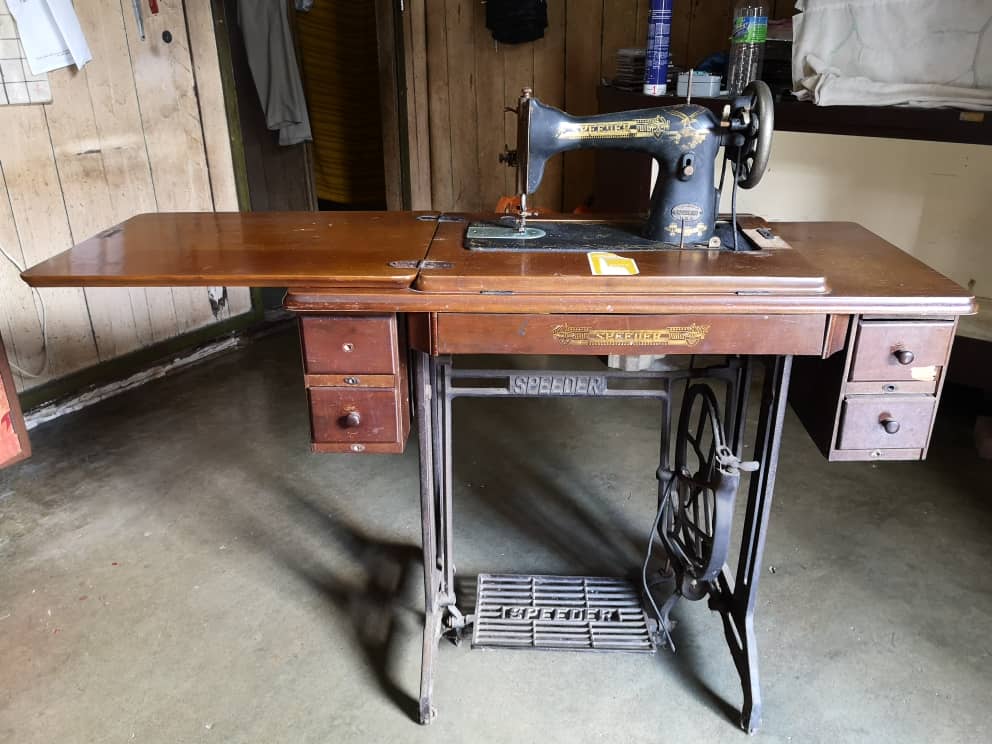
Four Generations and Counting
I will always remember the times I used to run into my grandparent’s bedroom on the eve of Chinese New Year. Often racing against my cousins to sit on a chair in front of a small table by my grandmother’s bedside. A little place that I liked to call my favourite spot. The wooden table itself was not big in size, and was often occupied by a covered object that took up most of the tablespace in the middle. But that was never a matter to me, for my favourite thing about the spot was the little pedal beneath the desk that I liked to spin.
It would only be a few years later when I learnt that the desk itself was actually a sewing machine cabinet in its entirety. An old Speeder model, estimated to have been manufactured over sixty years ago. I have not been able to identify the exact year it was made so far, because much to my great surprise, the brand ‘Speeder’ does not seem to exist at all. Nor does its company.
I understand that it had before belonged to my great-grandmother, and was something that she had gifted to my grandmother when she got married in the 1950s. From the stories my father would tell me, it was an item my grandmother had relied on a lot during his childhood, often using it to make and mend clothing for her family.
After my grandmother had passed, my uncle had asked if I wanted it. I seemed to be the only person in the family who had shown an interest in keeping it, and had happily accepted the item as my own. My father had been curious to know why I wanted it as the antique itself needed to be repaired before it was ready to be used again. To his question, I had simply answered, “Why not?”
To me, this sewing machine was a piece of our family’s history. Having survived and remained in the family for four generations, it was an irreplaceable heirloom. Something that I wanted to hold onto, as I hope to one day be able to date the antique and maybe even use it myself to sew. And who knows, perhaps in the future, I may even pass it on for the next generation to come! Passing on the memories.
-Janice Yap
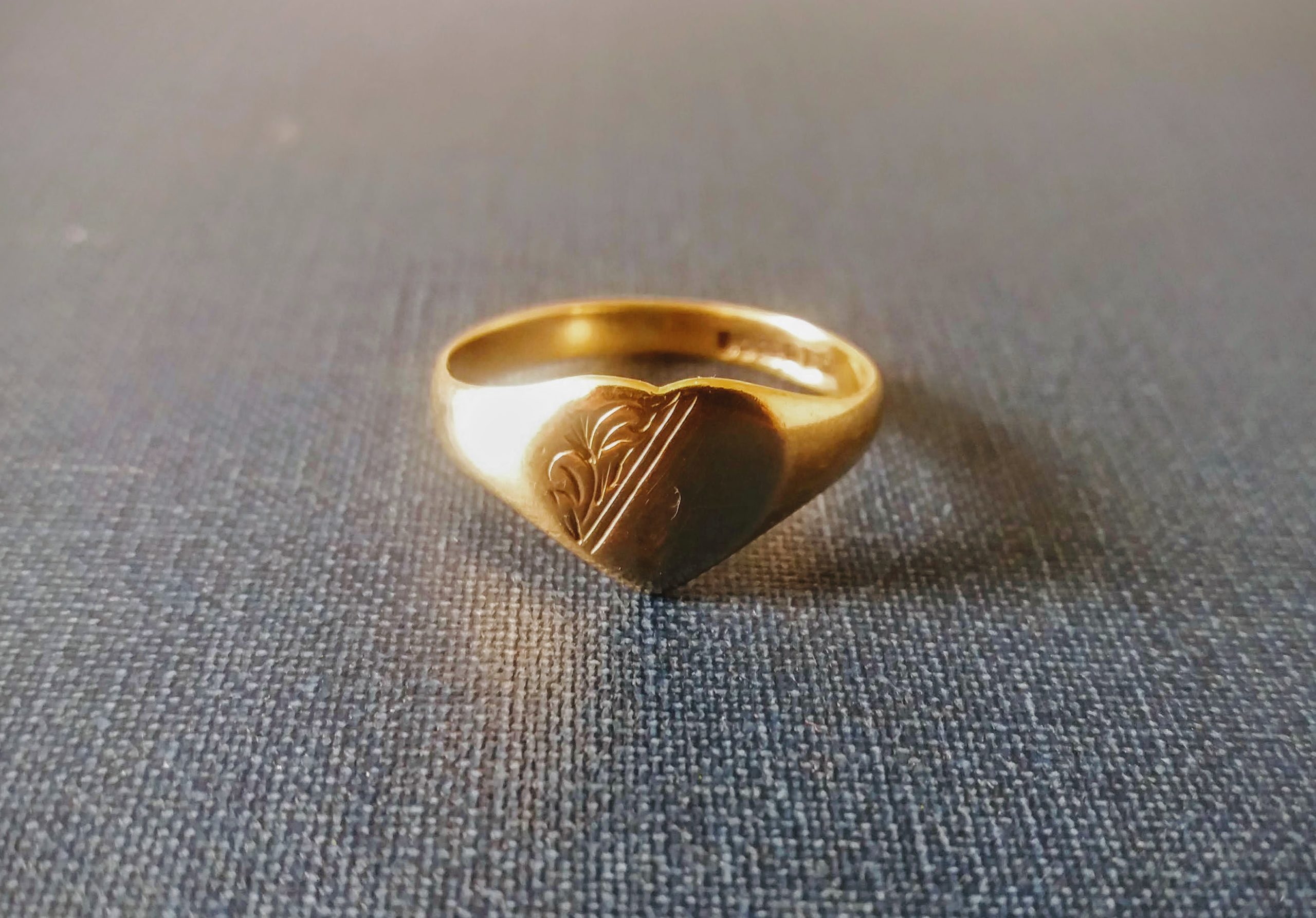
Freda's Ring
Heirlooms are scarce in my family. Coming from working class families, there has been little to pass on in the first place. Moreover, my maternal grandma suffered with severe mental illness, so photographs, documents and letters were burned. The stories that my mum and aunts tell about objects are more often stories of loss: the piano that there was no space for, the jewellery lost when they were robbed, the red dress left behind on a journey… but at some point after my grandma died, I got this ring.
As a ten-year-old, I didn’t question it much, but I have kept it.
When I asked family about it recently, they did not remember it at all. It’s unlikely that it was particularly special to my grandma in her lifetime. Although it has the style of a signet ring, the markings are purely decorative, without any family-specific additions. In a life in which jewellery could be a form of financial insurance, my grandma may well have bought it simply because it was going cheap. By looking up the hallmarks on the inside, I’ve confirmed that it is real gold – 9 carats and overseen by the Assay Office of Birmingham. Unfortunately, I haven’t found which business the hallmark refers to and the letter representing the date is now too obscured to read.
I have also done some research into my grandma’s family history. In recent years, several relatives have compiled an amazing family tree – as far back as the 1500s! But apart from records of marriages and births, there is little detail about their lives. What I know are the stories my family have passed down. Sometimes the stories are different when retold, altered by their many tellings through many voices, and their meaning has more to do with emotional bonds than factual accuracy.
This ring is much the same. Its meaning comes not from facts about it, but from the bond it represents for me. I wear it for special occasions, or days when I want a little extra confidence. It’s a way to carry my grandma, my family and my heritage with me. So I have kept it, and will keep it, wherever it came from.
– Sophie Small
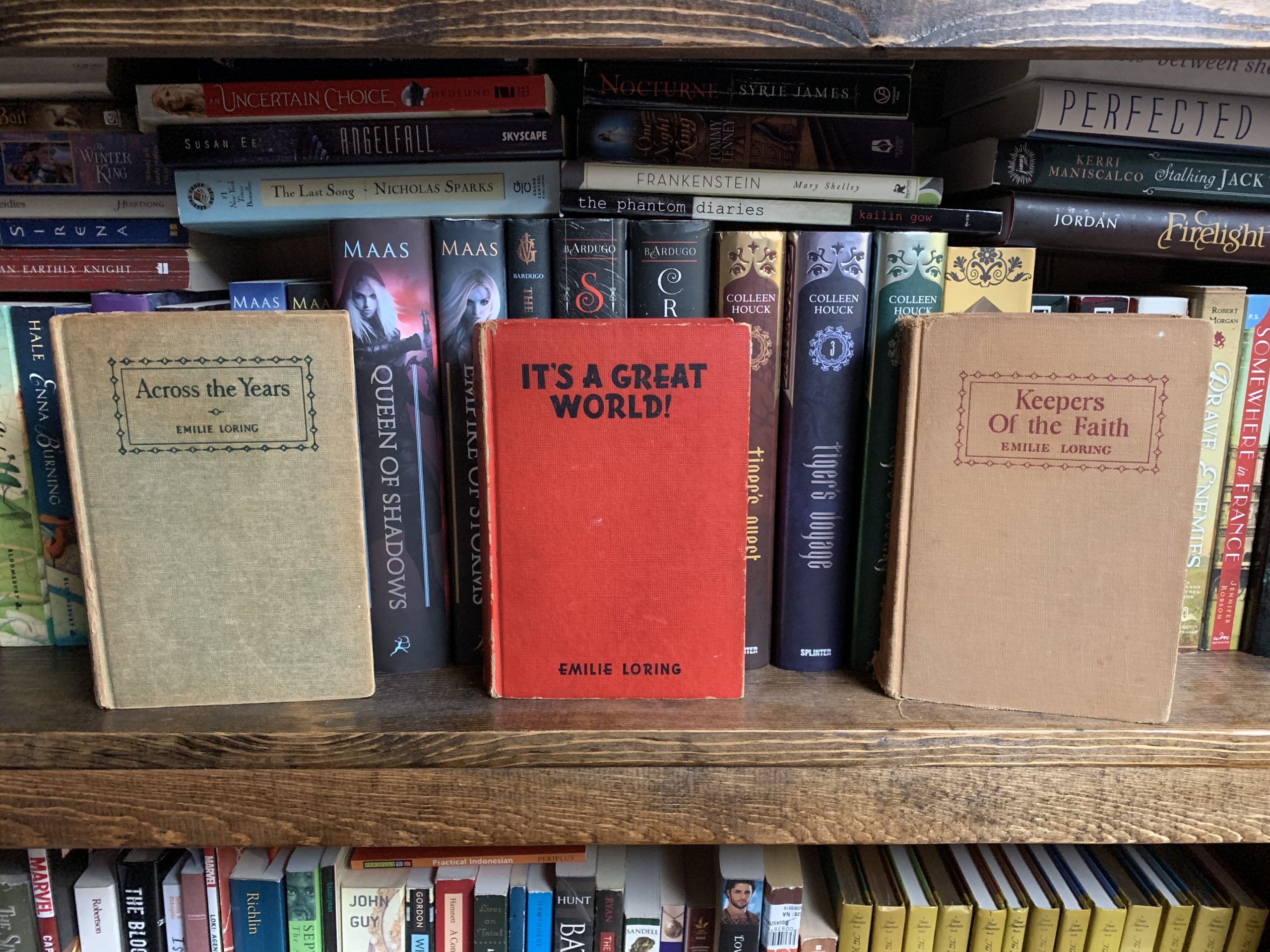
Borrowing Books
My family does not have any heirlooms that have been with us for generations, at least not ones I am aware of and can get the full story for. However, my mother has plenty of heirlooms given to her by her mother and two grandmothers over the years. One set of these heirlooms had particular special meaning for her because they came from her father’s mother, who, although she was not as close to my mother as some of her other grandchildren, was able to give her a gift representative of a vital aspect of my mother’s personality; her love of reading.
My mother usually borrowed books from her grandmother every time she visited her, and it was a special tradition between the two that only they shared. Nobody else in my mother’s immediate family shared books with her or bought her books to read on a regular basis, which is unfortunate considering my mother’s love of reading since she was a little girl. Emilie Loring was a particular favorite author of her grandmother’s and she often loaned my mother that author’s books because of this. My mother enjoyed them and continued to borrow them up until her grandmother died when she was starting high school. The Emilie Loring novels pictured with this blog post are the last ones my mother borrowed from her grandmother before she died, and consequently were never given back to their original owner. Mom keeps them in our library downstairs and plans to read them again soon.
This story is important to me because it represents a common thread connecting some of the women in my family, which is a reading hobby. I have mentioned this before in other posts, but thanks to my mother, I have loved reading since I was able to learn to do it. I read the entire Harry Potter series between third and fifth grade, and I read as much historical fiction about girls from the past as I could (some favorites were the Royal Diaries books by multiple authors and the American Girl novels by multiple authors). I even read several of the Emilie Loring novels my mother has in the basement back when I was in middle school and high school. Therefore, not only are these books important for my great grandmother and my mother’s childhood, but also my own girlhood. This passing of books from one female generation to the next in my family represents a bond between my mother and I and my great grandmother as well. Eventually, I hope to pass these books, along with many others, on to my own child.
– Elizabeth Bailey
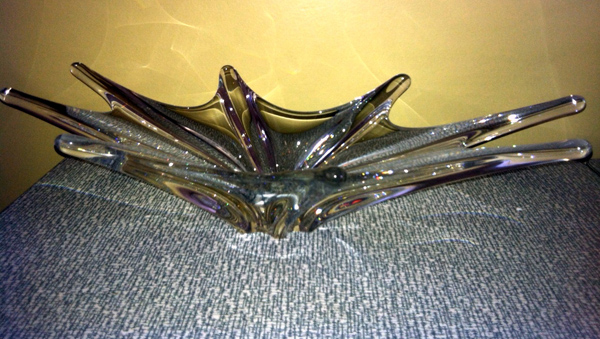
With Love from France
This beautiful lead crystal bowl was given to my mother by her grandmother. I have always admired it because it seems so unique. It came into my family when my grandfather sent it home from France for his mother, who handed it down to my mom. Upon asking more about it, I learned that it was from the Baccarat crystal factory in France.
My grandfather was stationed in Toul, France while he was in the army. He bought the bowl in Nancy, France. It was very expensive when he bought it, and then the post office would not insure it when he tried to send it home. Luckily, my great-grandmother received the bowl in Michigan in perfect condition.
– Hillary Hanel

Signed Photograph of The Beatles
This signed photo of The Beatles was given to mum when she was a teenager by her grandmother in the 1980s. Her grandmother had found the photograph in a book while working in a charity shop. My mum was a huge fan of The Beatles as a girl and has treasured the photograph ever since. It still sits proudly on her sideboard to this day.
What I really love about this object is the different ways in which it is timeless. Most obviously it is a photograph of a band who are themselves timeless. My mum loved The Beatles in the 1980s, twenty years after they were at the height of their fame and my parents still listed to them as I grew up decades later. Another thing about the photograph that is so timeless is what it represents. Teenage infatuation with celebrities or fictional characters is something I think many girls and women can relate to. Often female teenage desire is trivialised and labelled as ‘hysterical’. In fact, it was around the 1960s when bands such as The Beatles became popular that the stereotype of the hysterical teenage fan came about. Conflating girl’s desire and interest with hysteria and frivolity belittles their passions. This idea that girls’ passions are frivolous still permeates Western culture today.
What I like about this picture is that my grandmother knew my mum would love it because she knew my mum loved The Beatles. She didn’t think it was silly for my mum to love The Beatles and instead she wanted to engage with my mums’ interest. The fact that this image still sits on display in my mum’s house (all these years after her infatuation with The Beatles has melted away) shows that respecting girls’ interests can have a lasting impact. To me this object is a symbol of the importance of allowing girls to be passionate about things without labelling them as frivolous. It makes me happy every time I look at it to think of my mum overjoyed as a young teenager to have received this gift that was buried in a book, found by her grandmother and lovingly given to her. My mum has always encouraged all my interests however silly they might have seemed. If you raise girls to feel that their interests are valid, they will grow up unafraid to be passionate and that is what this object represents to me.
– Asha Hall-Jones
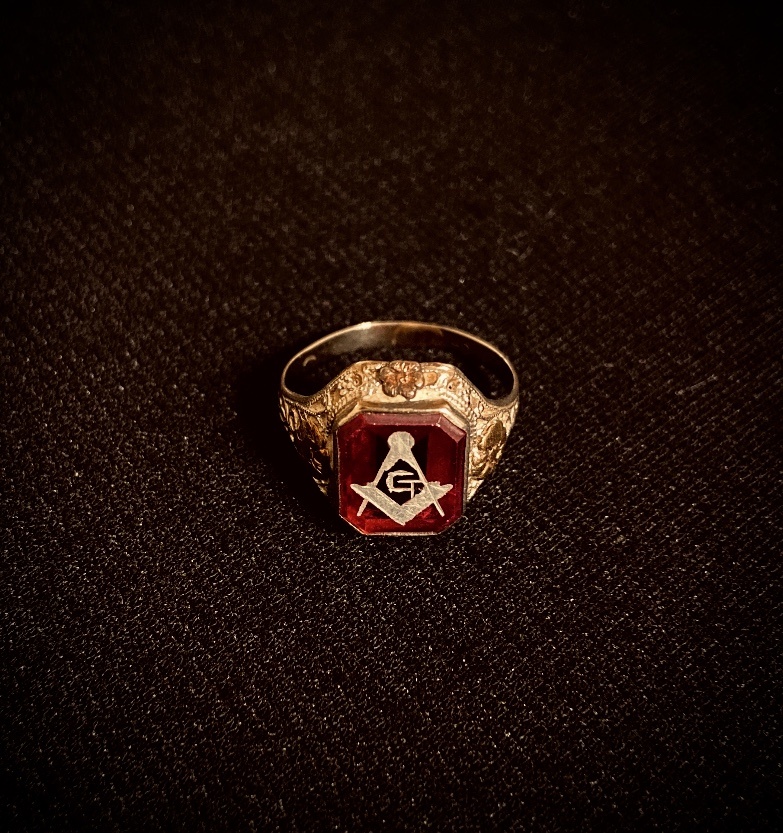
Mary-Elizabeth's Masonic Ring
My great-grandmother, Mary-Elizabeth, was born in 1914. Both of her parents passed away in 1918 from the Spanish flu. Now orphans, Mary-Elizabeth, her twin Edna, and her younger brother Hugh were sent to live in the Masonic Home of Fort Worth, Texas. Their father was a member of the Freemasons, so they were lucky to have a place to go after their parents passed. The Masonic school acted as an orphanage and provided schooling to the children until the age of 17. In 1931, at the age of 17, Mary-Elizabeth graduated from the Masonic school and was given this ring.
Mary-Elizabeth wore this ring for a few years after she graduated, always on her pinky finger as was custom. She wore it to remember her accomplishment of finishing school and as a reminder of where she came from. Though she and her siblings were well taken care of at the Masonic school, Mary-Elizabeth would often remember the coldness of the Masonic home. No one was very “touchy-feely” and it was no substitution for what she considered to be a real family. After she left, Mary-Elizabeth wanted nothing more than to start a family of her own. She wanted to create a sense of belonging by building the family that she had been missing for so much of her life.
This ring was a representation of Mary-Elizabeth’s family and the only connection to her father that she had left. It was also a symbol of her accomplishments in her studies. The seal of the red gem is that of the Freemasons. The square and compass symbolize the tools of the Freemasons as architects. The “G” in the center refers to God, as the greatest architect.
The masonic ring now sits in a safe in my grandmother’s home. It will continue to be passed down over the generations of women in my family as we remember Mary-Elizabeth. We will remember her strength and courage as she learned to navigate the world on her own as a young girl. We will continue to think of it as a symbol of her journey that would ultimately create the tight-knit family that we have today.
– Julianna Morris
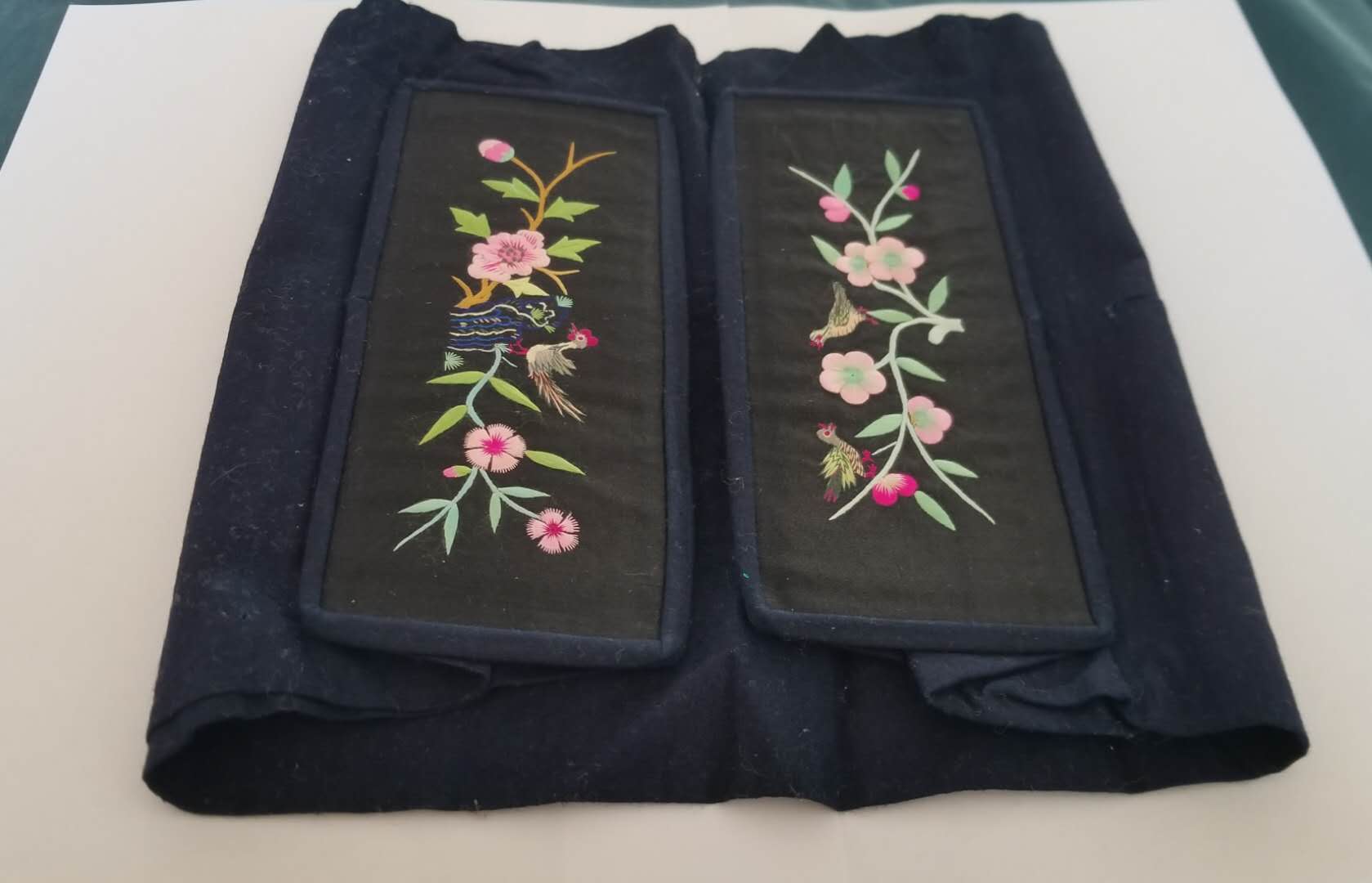
Handmade Pillow Case
My mother received this pillow case from her grandmother in 1981, when she was around 10 years old. I remember when I first saw it, I was amazed at how beautiful and detailed these patterns are. I learned that my great-grandmother sewed these herself. For her generation, all girls know how to sew since they were young.
My mother was raised by her grandmother in the Chinese countryside, her parents were too busy to raise another child at the time, so she was sent to my grandmother when she was only months old. Growing up in the countryside, my mother had a happy and carefree childhood. She was very close with her grandmother. Over the years, she often recounts her childhood memories to me as one of the happiest times in her life.
When my mother turned 10 years old, her grandmother twisted her feet accidently, therefore unable to continue taking care of my mother. She had to returned home to her parents in the city.
My great grandmother sewed this pillow case for my mother when she was leaving. My mother never used it. She carefully saved it and cherished it until today.
-Mengshu Ye
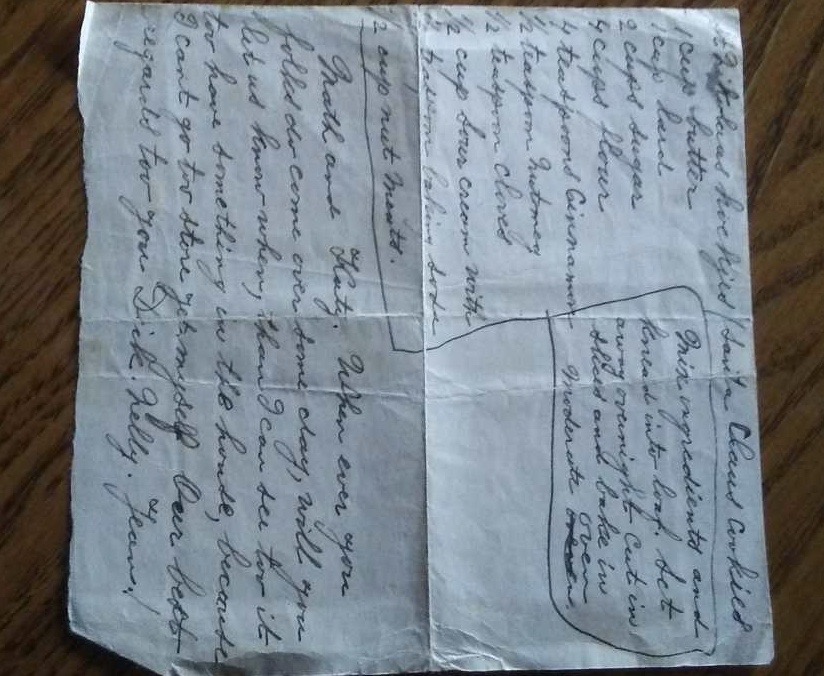
Recipe Card
My grandmother’s grandfather Matt lost both of his parents when he was very young. Since he came from a large family, his living relatives could not care for him and all of his siblings, so he was sent to live in an orphanage. When Matt was a teenager, he came to America from Holland with a group of other children from the orphanage. It was here in the states that he met and married his wife Kate. They settled in a Dutch community in Demotte, IN where they began to help fellow immigrants from Holland settle into America. They would help them find jobs and even host them until they had a place of their own to live.
While she was doing research into our family history, my grandmother actually discovered that one of the couples her grandparents took under their wing after they left Holland was my grandfather’s, her husband’s, grandparents. Once they got established in a home of their own in the States, my grandfather’s grandmother Nellie sent my grandmother’s grandmother Kate, whom they had stayed with, this recipe card for Santa Cookies. Written on the bottom of the card is a note inviting Matt and Kate to visit their new home if they are ever in the area.
– Emily VanderBent
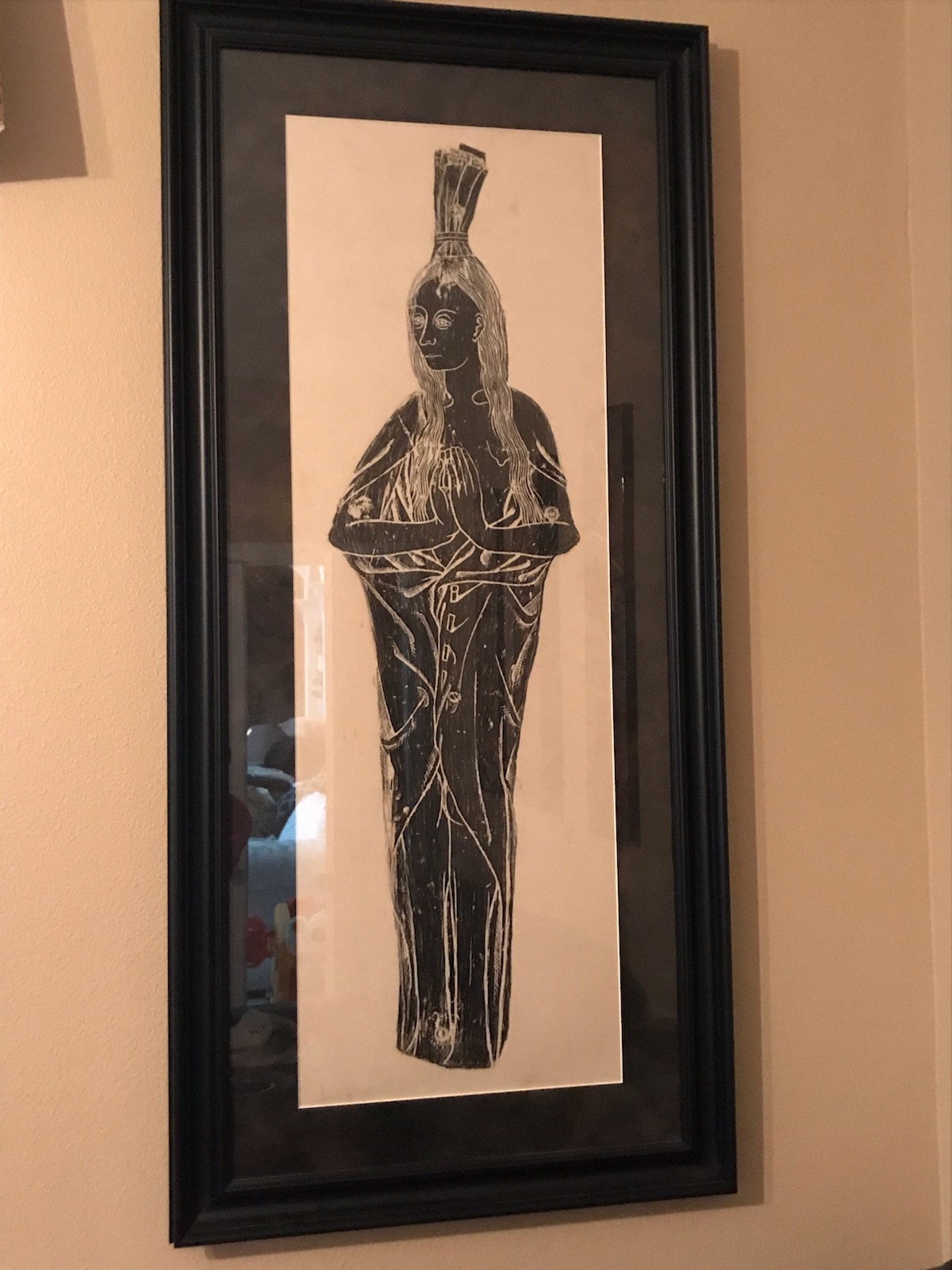
Brass Rubbing
This brass rubbing is one of three that my grandmother rubbed herself during my families time living in England almost 50 years ago. This rubbing of an unknown lady was done in the 1970s before the Westminster Abbey disallowed people to do rub their own pieces inside. My grandmother never told us who this brass rubbing was of, but she did always mention the lady’s funny hat, which I suspect is probably why my grandmother chose her.
My grandmother brought these back to Texas with her and unfortunately had them sitting in her house, rolled up, until after her death. She always wanted them framed and hung and talked about them often. When my mother inherited them, she asked me to get them matted and framed for better preservation. They have been hanging in my parents home ever since.
I absolutely love these rubbings and the story behind them. My grandmother loved history as much as I do, especially the odd and quirky history, so I can easily imagine my wily grandmother rubbing away at these, making jokes, and laughing. And it makes me smile.
— Ashley Winder, Texas, USA
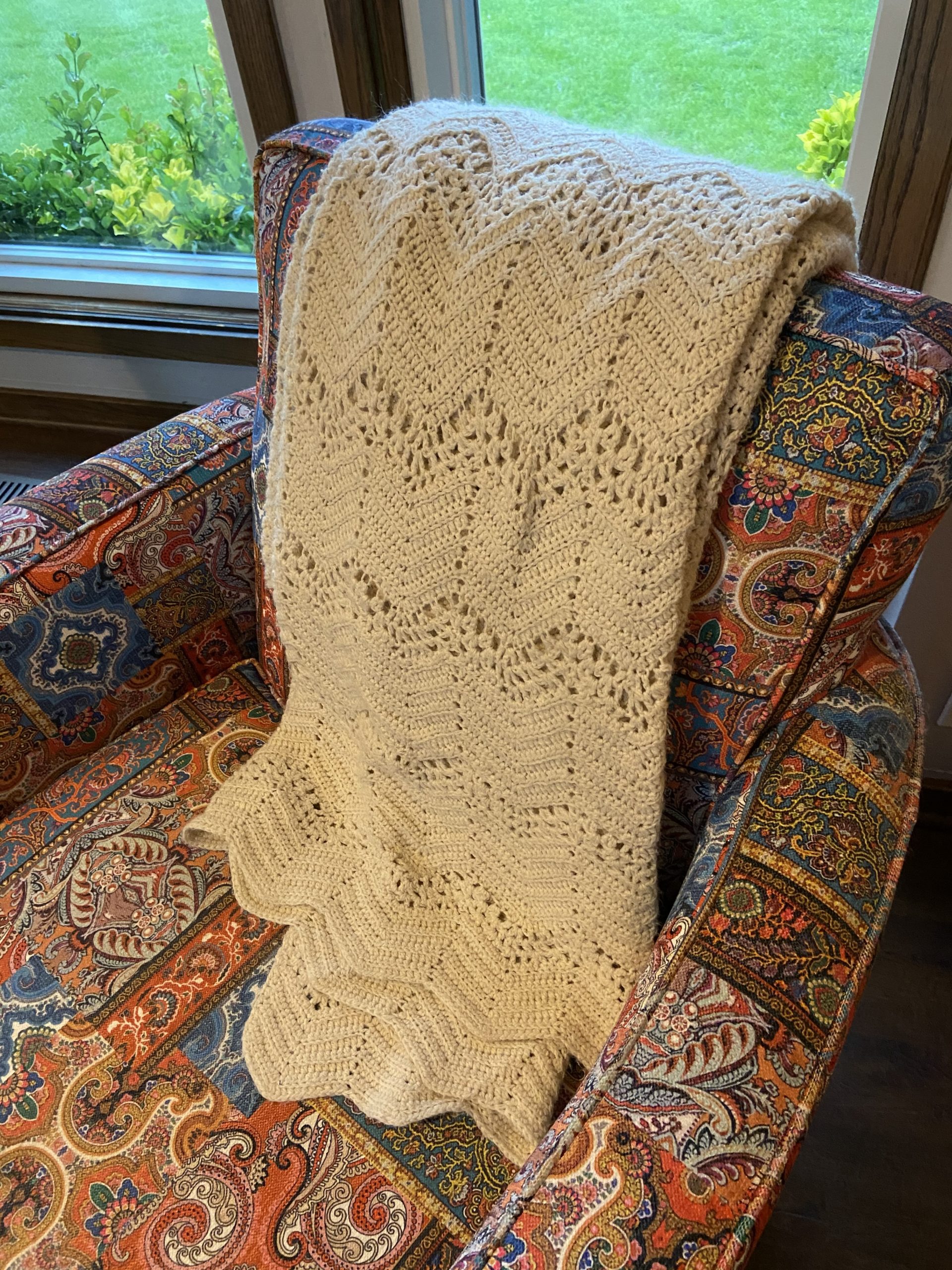
Crocheted Blanket
I love the heirlooms that we interact with every day, those mundane items that keep you in touch with those you love that can’t be with you anymore. On the back of my mom’s couch, there are two crocheted blankets. Both were made by my Great Grandma Blue. One was made for my grandma and the other for my mom on her wedding day. After my grandma died, my mother kept the other blanket.
My great grandma was very crafty. She was born in 1920 in Oklahoma and after high school decided to become a nurse. She got married in 1943. As a child her and her husband only lived a few miles from each other, but after her family moved they fell out of touch until he was visiting a friend in the hospital she worked at. My great grandad was in the military at the time. Due to his military service they moved around a lot, though he never served overseas. As a chemical engineer he spent most of his service working on the Manhattan project.
My great grandma gave birth to her first child in New York City, my grandma. Her second in Oak Ridge, Tennessee, and her third and fourth children in West Virginia. After the war they were able to settle in West Virginia for a while. My great grandad continued traveling for work, often internationally, but due to the frequent moving and four kids she didn’t have many friends. She crafted when the family wasn’t out on an adventure. My mom remembers how she would sew, do woodworking, and ran a small craft store out of the basement of her house. Her love of crafts was definitely passed down as well.
These two blankets are incredibly unique, but simple. Both are made of cream colored yarn and both have a chevron pattern. The sentimental value of them is not always something we recognize as we use them every day. But sometimes I realize that every day we are wrapped in a love that has been passed down through generations. My mom’s home is filled with similar objects. Things created by our family. Objects meant to be used and loved and remind us that we are cared for.
— Alexis Walker
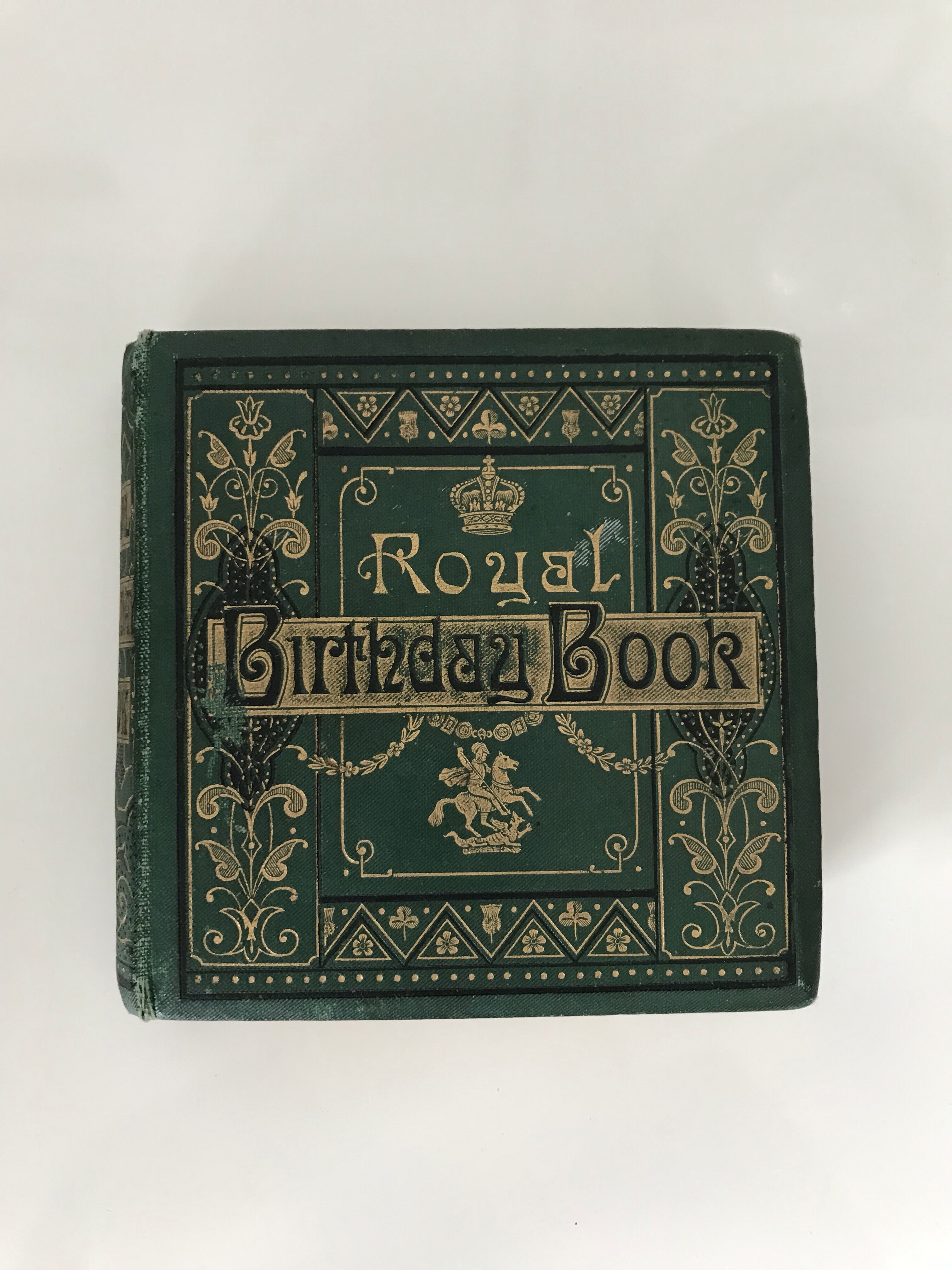
The Royal Birthday Book
When Sarah McFarlane left Scotland in September 1884, she had just turned 16. Sailing on the Lady Jocelyn with her parents and 13-year-old sister, Joan, Sarah was bound for a new life in Auckland, New Zealand. On such a significant personal journey, Sarah carried with her a small book titled the Royal Birthday Book. With an emerald-green cloth cover, golden embossing, and gilt edges, this tiny book is lavish: fit for its proclaimed royal status.
There are 20 handwritten names inscribed in the birthday book, including the names of Sarah’s five sisters, her aunts and uncles, and a few friends—both from Scotland and New Zealand. Sarah is my Great-Great-Aunt, and her book has travelled down through the generations to land in my care. I was intrigued by the inscription on the front page:
”With best wishes to Sarah McFarlane from her loving companion, Maggie McConachie, 22nd Sept 1884.’ So I set out to solve the mystery: Who was Maggie McConachie?
After much research, I finally found her. Margaret (Maggie) McConachie was only a few months younger than Sarah McFarlane. From at least 1881, Sarah and Maggie both lived in the same housing block, at 13 Antigua Street, Renfrewshire. As an only child living with her widowed moth, Maggie likely gravitated towards the large McFarlane clan with their six daughters, and particularly to Sarah, who was the same age. The Royal Birthday Book was a parting gift between girlhood friends. Three days after Maggie inscribed the Royal Birthday Book, Sarah set sail for Auckland—never to return to Scotland. Maggie remained in Renfrewshire, eventually going on to study music.
The two friends likely did not see each other again, but the strength of their friendship endures in the beautiful Royal Birthday Book. I am lucky to have such an heirloom that shows how far gifts of friendship can travel.
– Rosalie E.
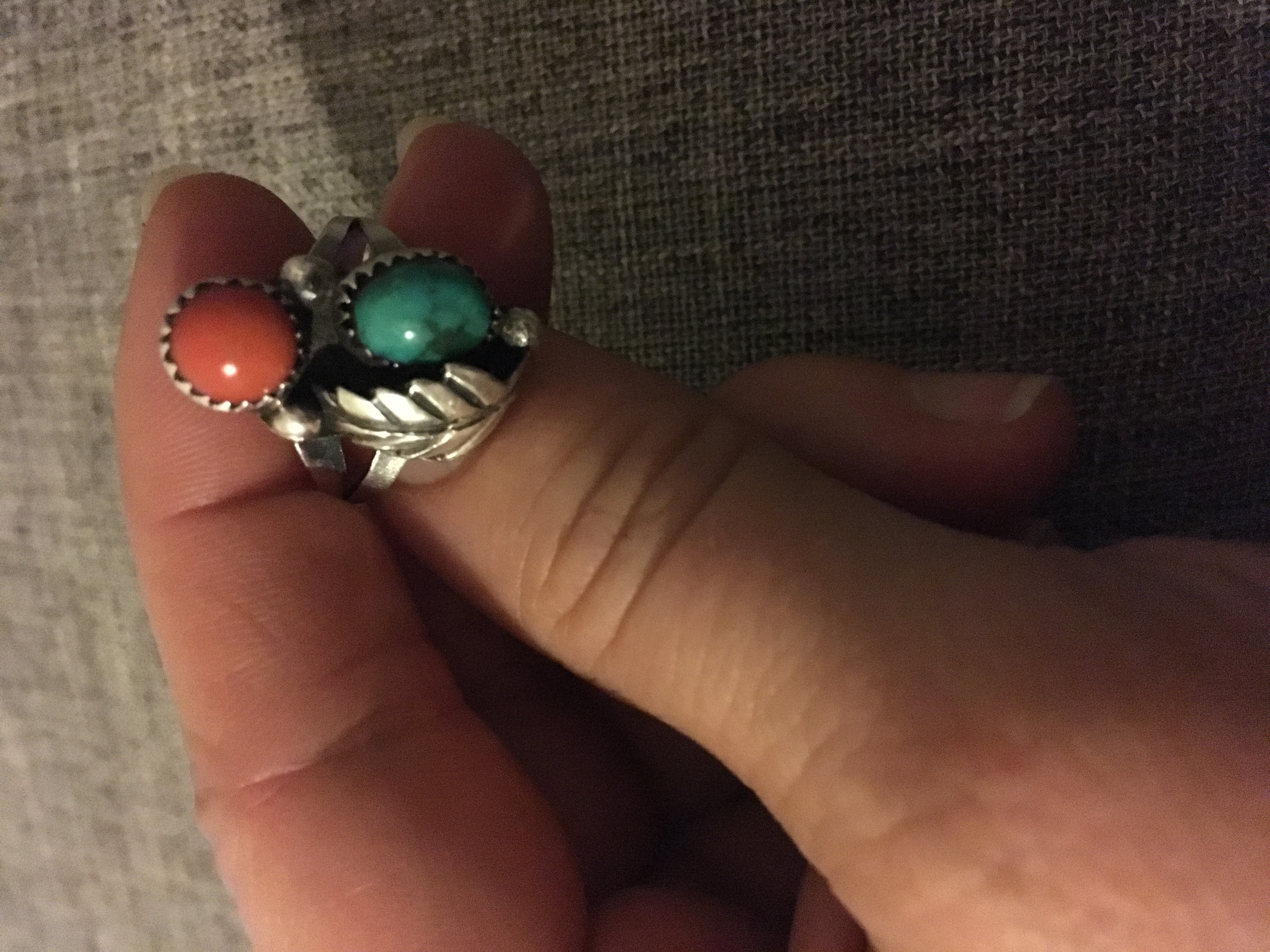
Grandmother Rene's Ring
To me this silver ring, decorated with turquoise and coral, has always been a family ring. I received it from my mother shortly after beginning college. I remember her making the remark that it seemed to “fit me”. Knowing who I’ve become, I like to think she meant my spirit. The ring once belonged to Laurene Dinsmore (Pruiet), my great-grandmother. She passed away when I was very young so I did not get a real chance to know her.
Growing up I heard stories that she had supported the Republican Party but I did not know to what extent. In recent years and after turning to the internet, I was able to connect childhood stories to some newspaper clippings. Not only did it confirm her involvement in the party, but it also named her as chairwoman during the campaigns of 1952 and 1956. Campaigns that supported former President Eisenhower. I am told that she wore the ring along with several other pieces as symbols of the State of New Mexico to the National Conventions for those years. I find it rather amazing how one small ring can connect you, not only to your family, but also to larger events of the past.
– Brittany H.
With Thanks To:
Marketing Partner: Blue Moon Girls Media
Partner: Chick History
Supporters: Seton Shields Genealogical Grants
